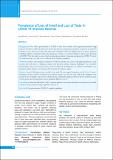Please use this identifier to cite or link to this item:
https://hdl.handle.net/20.500.14356/1010Full metadata record
| DC Field | Value | Language |
|---|---|---|
| dc.contributor.author | Shrestha, Sujan | - |
| dc.contributor.author | Paudel, Asmita | - |
| dc.contributor.author | Shrestha, Sepiya | - |
| dc.contributor.author | Gautam, Amrit | - |
| dc.contributor.author | Bhurtel, Minraj | - |
| dc.contributor.author | Adhikari, Purushottam | - |
| dc.date.accessioned | 2023-04-19T10:49:27Z | - |
| dc.date.available | 2023-04-19T10:49:27Z | - |
| dc.date.issued | 2022 | - |
| dc.identifier.citation | ShresthaS., PaudelA., ShresthaS., GautamA., BhurtelM., & AdhikariP. (2022). Prevalence of Loss of Smell and Loss of Taste in COVID-19 Infected Patients. Journal of Nepal Health Research Council, 20(01), 84-88. https://doi.org/10.33314/jnhrc.v20i01.3852 | en_US |
| dc.identifier.issn | Print ISSN: 1727-5482; Online ISSN: 1999-6217 | - |
| dc.identifier.uri | http://103.69.126.140:8080/handle/20.500.14356/1010 | - |
| dc.description | Original Article | en_US |
| dc.description.abstract | Abstract Background: The clinical presentations of COVID-19 have been variable, with atypical presentations being reported worldwide. Different studies have shown that olfactory and gustatory symptoms are present in confirmed COVID-19 cases, who may not have had other nasal complaints earlier. The high prevalence of these symptoms, exhibiting olfactory dysfunction before the appearance of others, is a relevant finding to aid for early detection of COVID-19. In this study, we aim to find out about the prevalence of anosmia and ageusia in COVID-19 and its correlation with age, sex, and severity of disease in the Nepalese population. Methods: Patients with laboratory-confirmed COVID-19 infection by reverse transcription-polymerase chain reaction (RT-PCR) done at Shukraraaj Tropical and Infectious Disease Hospital, Kathmandu were recruited. Questionnaires based on loss of taste and loss of smell components including age, sex, ethnicity, comorbidities were prepared, and the patients were interviewed retrospectively by phone contact. Results: A total of 300 patients were enrolled in our study. The mean age of the patients was 38.36±14.24 years. Prevalence of loss of smell was 54%(N=162) and loss of taste was 53% (N=159). Both of the symptoms were present in 45% of patients. The severity of the disease has a statistically significant effect on the loss of smell and taste whereas gender and smoking history has no significant difference over it. Conclusions: More than half of the COVID-19 positive patients in our cohort had either loss of taste or loss of smell with the severity of disease having a significant effect on it. Keywords: Ageusia; anosmia; COVID-19; nepalese population. | en_US |
| dc.language.iso | en | en_US |
| dc.publisher | Nepal Health Research Council | en_US |
| dc.relation.ispartofseries | Jan-March, 2022;3852 | - |
| dc.subject | Ageusia | en_US |
| dc.subject | anosmia | en_US |
| dc.subject | COVID-19 | en_US |
| dc.subject | nepalese population | en_US |
| dc.title | Prevalence of Loss of Smell and Loss of Taste in COVID-19 Infected Patients | en_US |
| dc.type | Journal Article | en_US |
| local.journal.category | Original Article | - |
| Appears in Collections: | Vol. 20 No. 01 (2022): Issue 54 Jan-March, 2022 | |
Files in This Item:
| File | Description | Size | Format | |
|---|---|---|---|---|
| 3852-Manuscript-27872-1-10-20220606.pdf | Fulltext Download | 177.47 kB | Adobe PDF |  View/Open |
Items in DSpace are protected by copyright, with all rights reserved, unless otherwise indicated.
